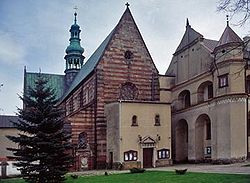
Cistercians Abbey in Wachock
Encyclopedia

Abbey
An abbey is a Catholic monastery or convent, under the authority of an Abbot or an Abbess, who serves as the spiritual father or mother of the community.The term can also refer to an establishment which has long ceased to function as an abbey,...
in Wąchock
Wachock
Wąchock is a town in Starachowice County, Świętokrzyskie Voivodeship, Poland, near Starachowice. In 2006, it had 2,777 inhabitants.- History :...
, Poland
Poland
Poland , officially the Republic of Poland , is a country in Central Europe bordered by Germany to the west; the Czech Republic and Slovakia to the south; Ukraine, Belarus and Lithuania to the east; and the Baltic Sea and Kaliningrad Oblast, a Russian exclave, to the north...
. Located near the larger town of Starachowice
Starachowice
Starachowice is a town in south-central Poland with 55,126 inhabitants . Starachowice is situated in the Świętokrzyskie Voivodeship ; it was formerly in the Kielce Voivodeship . It is the capital of Starachowice County...
in the Świętokrzyskie Mountains
Swietokrzyskie Mountains
Świętokrzyskie Mountains , are a mountain range in central Poland, in the vicinity of the city of Kielce. The mountain range consists of a number of separate ranges, the highest of which is Łysogóry . The two highest peaks are Łysica at 612 meters and Łysa Góra at 593 meters...
of south-eastern Poland, Wąchock is best known for the architecture of this Roman Catholic site.
The abbey was founded by Cistercian monks, who came to the region in the late 12th century.
The Cistercians had a reputation for administering the building sites for abbeys and cathedrals, and "made it a point of honour to recruit the best stonecutters." Today, the interiors of the abbey remain well-preserved, and the buildings themselves "are recognized as the most precious monuments of Romanesque architecture
Romanesque architecture
Romanesque architecture is an architectural style of Medieval Europe characterised by semi-circular arches. There is no consensus for the beginning date of the Romanesque architecture, with proposals ranging from the 6th to the 10th century. It developed in the 12th century into the Gothic style,...
in Poland."
History

Saint Florian
Florian lived in the time of the Roman emperors Diocletian and Maximian, and was commander of the imperial army in the Roman province of Noricum. In addition to his military duties, he was also responsible for organizing firefighting brigades....
, was completed prior to the Tatar Invasion of 1241. This incursion, and the Mongol invasions to follow, destroyed most of the monastery, and the bulk of what Romanesque work stands today was rebuilt in the late 13th century.
The abbey, like many Cistercian monasteries, prospered over the next several centuries, farming and earning income from metal mining and manufacturing operations. Another series of invasions, culminating with that of George II Rákóczi
George II Rákóczi
György Rákóczi II , a Transylvanian Hungarian ruler, was the eldest son of George I and Susanna Lorantffy....
of Transylvania
Transylvania
Transylvania is a historical region in the central part of Romania. Bounded on the east and south by the Carpathian mountain range, historical Transylvania extended in the west to the Apuseni Mountains; however, the term sometimes encompasses not only Transylvania proper, but also the historical...
, left the abbey plundered and burnt. The monastery was finally rebuilt in 1696. It was suppressed, and the church converted to a parish church, in 1819 following the Congress of Vienna
Congress of Vienna
The Congress of Vienna was a conference of ambassadors of European states chaired by Klemens Wenzel von Metternich, and held in Vienna from September, 1814 to June, 1815. The objective of the Congress was to settle the many issues arising from the French Revolutionary Wars, the Napoleonic Wars,...
, which had created the "Kingdom of Poland
Congress Poland
The Kingdom of Poland , informally known as Congress Poland , created in 1815 by the Congress of Vienna, was a personal union of the Russian parcel of Poland with the Russian Empire...
" five years earlier as a de facto puppet state
Puppet state
A puppet state is a nominal sovereign of a state who is de facto controlled by a foreign power. The term refers to a government controlled by the government of another country like a puppeteer controls the strings of a marionette...
of the Russian Empire
Russian Empire
The Russian Empire was a state that existed from 1721 until the Russian Revolution of 1917. It was the successor to the Tsardom of Russia and the predecessor of the Soviet Union...
under the Romanov Tsars. In 1951, Cistercians from Mogila
Mogila
Mogila is a village in the south of the Republic of Macedonia. It is a seat of the Mogila municipality. The village is located in Pelagonia, north-east of the city of Bitola...
were finally able to return to the monastery at Wąchock, and in 1964 the parish once again returned to its former status as an abbey. In 1991, the Fathers opened a museum on the abbey premises.

